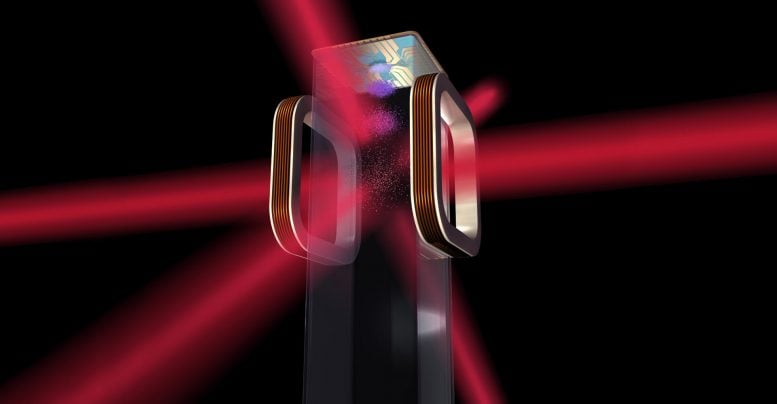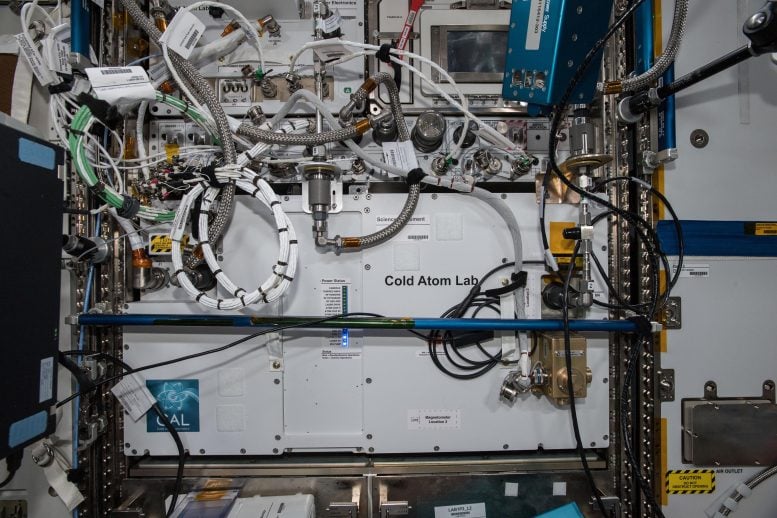
NASA’s Cold Atom Lab on the International Space Station uses quantum technology for advanced space science, offering new insights into gravitational fields, dark matter, and dark energy, and testing aspects of general relativity in microgravity.
Future space missions could use quantum technology to track water on Earth, explore the composition of moons and other planets, or probe mysterious cosmic phenomena.
NASA’s Cold Atom Lab, a first-of-its-kind facility aboard the International Space Station (ISS), has taken another step toward revolutionizing how quantum science can be used in space. Members of the science team measured subtle vibrations of the space station with one of the lab’s onboard tools — the first time ultra-cold atoms have been employed to detect changes in the surrounding environment in space.
The study, published in Nature Communications on August 13, also reports the longest demonstration of the wave-like nature of atoms in freefall in space.
Advances in Quantum Measurements
The Cold Atom Lab science team made their measurements with a quantum tool called an atom interferometer, which can precisely measure gravity, magnetic fields, and other forces. Scientists and engineers on Earth use this tool to study the fundamental nature of gravity and advance technologies that aid aircraft and ship navigation. (Cell phones, transistors, and GPS are just a few other major technologies based on quantum science but do not involve atom interferometry.)
NASA’s Cold Atom Laboratory on the International Space Station is regularly the coldest known spot in the universe. But why are scientists producing clouds of atoms a fraction of a degree above absolute zero? And why do they need to do it in space? Quantum physics, of course. Here’s how CAL is helping scientists learn more about the physics behind things like miniaturized technology and the fundamental nature of the particles that make up everything we see. Credit: NASA Jet Propulsion Laboratory
Physicists have been eager to apply atom interferometry in space because the microgravity there allows longer measurement times and greater instrument sensitivity, but the exquisitely sensitive equipment has been considered too fragile to function for extended periods without hands-on assistance. The Cold Atom Lab, which is operated remotely from Earth, has now shown it’s possible.
“Reaching this milestone was incredibly challenging, and our success was not always a given,” said Jason Williams, the Cold Atom Lab project scientist at NASA’s Jet Propulsion Laboratory in Southern California. “It took dedication and a sense of adventure by the team to make this happen.”

Gravitational Insights and Beyond
Space-based sensors that can measure gravity with high precision have a wide range of potential applications. For instance, they could reveal the composition of planets and moons in our solar system, because different materials have different densities that create subtle variations in gravity.
This type of measurement is already being performed by the U.S.-German collaboration GRACE-FO (Gravity Recovery and Climate Experiment Follow-on), which detects slight changes in gravity to track the movement of water and ice on Earth. An atom interferometer could provide additional precision and stability, revealing more detail about surface mass changes.
Precise measurements of gravity could also offer insights into the nature of dark matter and dark energy, two major cosmological mysteries. Dark matter is an invisible substance five times more common in the universe than the “regular” matter that composes planets, stars, and everything else we can see. Dark energy is the name given to the unknown driver of the universe’s accelerating expansion.
“Atom interferometry could also be used to test Einstein’s theory of general relativity in new ways,” said University of Virginia professor Cass Sackett, a Cold Atom Lab principal investigator and co-author of the new study. “This is the basic theory explaining the large-scale structure of our universe, and we know that there are aspects of the theory that we don’t understand correctly. This technology may help us fill in those gaps and give us a more complete picture of the reality we inhabit.”
NASA’s Cold Atom Lab studies the quantum nature of atoms, the building blocks of our universe, in a place that is out of this world – the International Space Station. This animated explainer explores what quantum science is and why NASA wants to do it in space. Credit: NASA/JPL-Caltech
The Cold Atom Lab: A Microgravity Quantum Laboratory
About the size of a minifridge, the Cold Atom Lab launched to the space station in 2018 with the goal of advancing quantum science by putting a long-term facility in the microgravity environment of low Earth orbit. The lab cools atoms to almost absolute zero, or minus 459 degrees Fahrenheit (minus 273 degrees Celsius). At this temperature, some atoms can form a Bose-Einstein condensate, a state of matter in which all atoms essentially share the same quantum identity. As a result, some of the atoms’ typically microscopic quantum properties become macroscopic, making them easier to study.
Quantum properties include sometimes acting like solid particles and sometimes like waves. Scientists don’t know how these building blocks of all matter can transition between such different physical behaviors, but they’re using quantum technology like what’s available on the Cold Atom Lab to seek answers.
In microgravity, Bose-Einstein condensates can reach colder temperatures and exist for longer, giving scientists more opportunities to study them. The atom interferometer is among several tools in the facility enabling precision measurements by harnessing the quantum nature of atoms.
Due to its wave-like behavior, a single atom can simultaneously travel two physically separate paths. If gravity or other forces are acting on those waves, scientists can measure that influence by observing how the waves recombine and interact.
Exploring Quantum Futures
“I expect that space-based atom interferometry will lead to exciting new discoveries and fantastic quantum technologies impacting everyday life, and will transport us into a quantum future,” said Nick Bigelow, a professor at University of Rochester in New York and Cold Atom Lab principal investigator for a consortium of U.S. and German scientists who co-authored the study.
Reference: “Pathfinder experiments with atom interferometry in the Cold Atom Lab onboard the International Space Station” by Jason R. Williams, Charles A. Sackett, Holger Ahlers, David C. Aveline, Patrick Boegel, Sofia Botsi, Eric Charron, Ethan R. Elliott, Naceur Gaaloul, Enno Giese, Waldemar Herr, James R. Kellogg, James M. Kohel, Norman E. Lay, Matthias Meister, Gabriel Müller, Holger Müller, Kamal Oudrhiri, Leah Phillips, Annie Pichery, Ernst M. Rasel, Albert Roura, Matteo Sbroscia, Wolfgang P. Schleich, Christian Schneider, Christian Schubert, Bejoy Sen, Robert J. Thompson and Nicholas P. Bigelow, 13 August 2024, Nature Communications.
DOI: 10.1038/s41467-024-50585-6
More About the Cold Atom Lab
NASA’s Cold Atom Lab, situated aboard the International Space Station (ISS), represents a groundbreaking effort to harness quantum technology in the unique microgravity environment of space. Launched in 2018, this compact laboratory, about the size of a minifridge, cools atoms to nearly absolute zero, creating conditions where quantum phenomena can be observed more clearly than on Earth.
The lab’s primary tool, an atom interferometer, enables precise measurements of gravitational forces, offering insights into the fundamental nature of gravity and potential clues about dark matter and dark energy. By exploiting the prolonged state of freefall aboard the ISS, the Cold Atom Lab provides an unparalleled platform for advancing quantum science, potentially leading to new technologies and deeper understanding of the universe.
source: scitechdaily.com